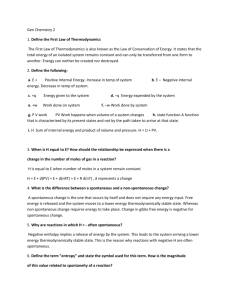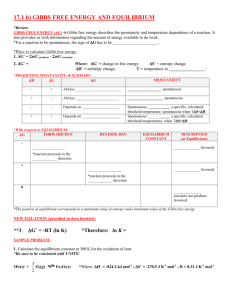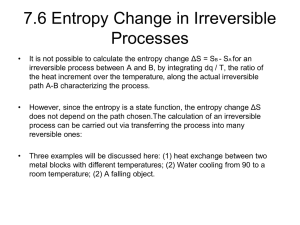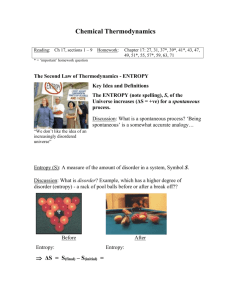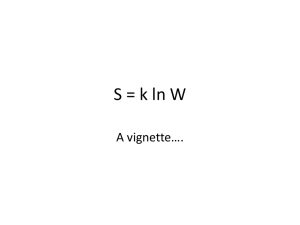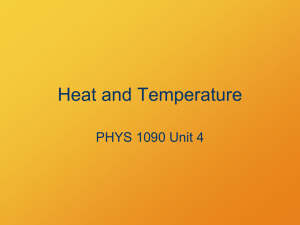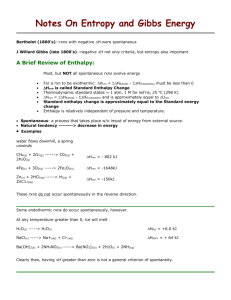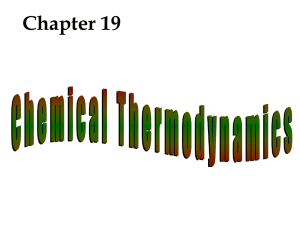Gibbs Free Energy HL
advertisement
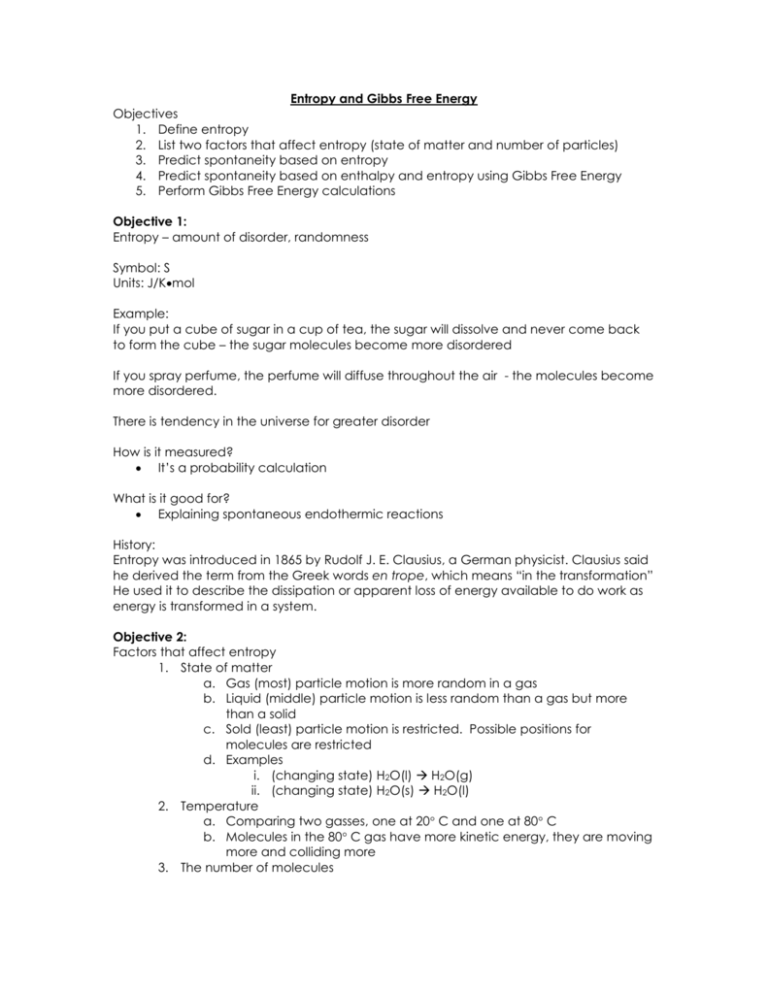
Entropy and Gibbs Free Energy Objectives 1. Define entropy 2. List two factors that affect entropy (state of matter and number of particles) 3. Predict spontaneity based on entropy 4. Predict spontaneity based on enthalpy and entropy using Gibbs Free Energy 5. Perform Gibbs Free Energy calculations Objective 1: Entropy – amount of disorder, randomness Symbol: S Units: J/Kmol Example: If you put a cube of sugar in a cup of tea, the sugar will dissolve and never come back to form the cube – the sugar molecules become more disordered If you spray perfume, the perfume will diffuse throughout the air - the molecules become more disordered. There is tendency in the universe for greater disorder How is it measured? It’s a probability calculation What is it good for? Explaining spontaneous endothermic reactions History: Entropy was introduced in 1865 by Rudolf J. E. Clausius, a German physicist. Clausius said he derived the term from the Greek words en trope, which means “in the transformation” He used it to describe the dissipation or apparent loss of energy available to do work as energy is transformed in a system. Objective 2: Factors that affect entropy 1. State of matter a. Gas (most) particle motion is more random in a gas b. Liquid (middle) particle motion is less random than a gas but more than a solid c. Sold (least) particle motion is restricted. Possible positions for molecules are restricted d. Examples i. (changing state) H2O(l) H2O(g) ii. (changing state) H2O(s) H2O(l) 2. Temperature a. Comparing two gasses, one at 20 C and one at 80 C b. Molecules in the 80 C gas have more kinetic energy, they are moving more and colliding more 3. The number of molecules a. More molecules means more possible positions relative to the other molecules i. (more moles and change of state) Li2CO3(s) Li2O(s) + CO2(g) ii. (more moles) MgSO48H2O Mg2+(aq) + SO42-(aq) + 8H2O(l) 4. More complex molecules have higher entropy values Is entropy an extensive or intensive property? Extensive because it depends upon the amount of mass Objective 3: Predictions 1. Ag+1 + Cl-1 AgCl(s) 2. 2 Fe(s) + O2(g) 2 FeO (s) 3. NaCl Na+1 + Cl-1 Objective 4: Which is more important enthalpy or entropy? Gibbs Free Energy Josiah Willard Gibbs (1839-1903) was little known during his lifetime of work at Yale University in Connecticut. Gibbs Free Energy is the available, useful energy from a process Spontaneous: a process that is likely to occur without the continuous input of energy If G > 0, not spontaneous If G < 0, spontaneous The following equation can be used to predict spontaneity: G = H - TS Notice that entropy is affected by temperature H S G Spontaneous Negative Positive Negative YES Positive Negative Positive NO Depends on H Negative Negative Depends compared to S Positive Positive Depends YES at high Temperatures Gibbs Free Energy Calculations Objective 5: Example calculation: Given that the changes in enthalpy and entropy are -139 kJ and 277 J/K respectively for the reaction given below, calculate the change in Gibbs energy. Then state whether the reaction is spontaneous at 25 C C6H12O6(aq) 2C2H5OH(aq) + 2CO2(g) (this reaction is used in baking) H = -139 kJ 139000 J S = 277 J/K T = 25 C 25 + 273.15 = 298.15 K G = ? Plug into the equation: G = 139000 J – (298.15 K)( 277 J/K) = -222000 J = -222 kJ Determine Spontaneity Is G < 0 ? Yes, than the reaction is spontaneous Summary of Thermodynamics Three laws of Thermodynamics 0th Thermal Equilibrium 1st Law of Conservation of Energy 2nd Increasing entropy

